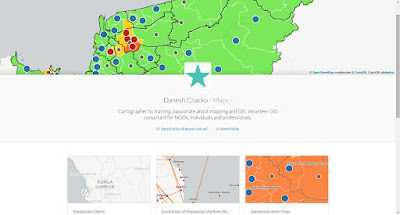Recently, my post on Vegetation Maps and Stimulated Minds sparked some discussions on missing information and gaps on the maps (why the sea is red or the lakes are missing). It hit me to the core that when I produce the map, I need to ensure the maximum amount of perceived accuracy and proper cartographic representation for the maps I produce.
Hence, I commenced a continuous project to create a geodatabase of freely available of GIS data of Malaysia (since Malaysia do not practice open data - hence the search gets difficult). Coincidentally, the big GIS FB group Admin talked about collecting datasets to make it available to anyone in the group (last count : more than 5000 members)
As I am regular producer of Malaysian maps for many people, I have assembled (work in progress) a list of sources. For those who are interested with complete metadata description (terms of usage etc.), please contact me directly on the blog.
Administrative Boundaries/Electoral Boundaries
- http://www.diva-gis.org/ (Coarse resolution ,outdated boundaries of state, district level boundaries - Perak Boundary is inaccurate, Labuan has been omitted) - home to other coarse resolution data like roads, population density
- https://revolutionarygis.wordpress.com/2014/03/17/malaysia-states/ (Fairly accurate state boundaries of Malaysia - no statement on terms of usage)
- For Electoral boundaries, there is no freely available spatial data (please lodge the request privately to me and I will seek approval from the source)
Topography/Bathymetry/ Physical Features
- https://www.bodc.ac.uk/data/online_delivery/gebco/gebco_30_second_grid/ (For bathymetry for general purpose - please do not distribute the data from one person to another, download straight from the website)
- http://gdem.ersdac.jspacesystems.or.jp/ (Topography for non-commercial purposes)
- http://earthexplorer.usgs.gov/ (Topography data (coarser resolution))
- http://topotools.cr.usgs.gov/gmted_viewer/viewer.htm (Coarser resolution for Topographic data)
- http://geonames.nga.mil/gns/html/namefiles.html (For hydrographic, hypsographic features in excel format with coordinates). Those who want to access a cleaner version, please contact me privately
Water Body/Rivers
- http://extract.bbbike.org/ (Downloading freely available Open Street Map Data of all vector features including rivers and water bodies - not complete)
- http://openstreetmapdata.com/data/water-polygons (Water Polygons for coastlines, sea and oceans)
- http://gcmd.nasa.gov/records/GCMD_GLWD.html (Lake and Wetlands)
- http://www.worldwildlife.org/pages/global-lakes-and-wetlands-database (For non-commercial purposes, water bodies)
Vegetation/National Parks
- http://earthenginepartners.appspot.com/science-2013-global-forest/download_v1.2.html (Forest cover, changes)
- http://www.protectedplanet.net/country/MY (National Parks for non-commercial purposes)
- http://geonames.nga.mil/gns/html/namefiles.html (Gazetteer for estate, forest reserves and other vegetation features)
Mineral Resources
- https://www.prio.org/Data/Geographical-and-Resource-Datasets/Petroleum-Dataset/Petroleum-Dataset-v-12/ (Petroleum and Gas Deposits)
- http://minerals.usgs.gov/minerals/ (Might be outdated data of mining sites of Malaysia)
Human Built Features
- http://extract.bbbike.org/ (For roads, railway, points of interests and other human built features
- For North-South Highway assets (i.e. SOS telephones, points of interest), please contact me directly for data distribution.
- http://geonames.nga.mil/gns/html/namefiles.html (Gazetteer for selected human built features - population areas, transportation features)
If you know any additional sources, please contact me and will update the source. For those who want the data with proper documentation and metadata, contact me via the blog. We can talk more on data distribution
























